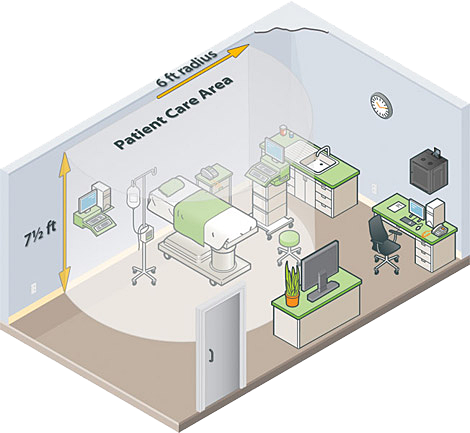
Selecting power products compliant with stringent safety regulations is an essential but often confusing part of a healthcare manager’s job. If you are purchasing power strips, surge protectors, isolation transformers or uninterruptable power supplies for your facility, the following questions and answers will help you make an informed choice.
1. What is the difference between the patient-care room and the patient-care vicinity?
A patient-care room is defined in section 3.3.138 NFPA 99-2012 as “any space within a healthcare facility wherein patients are intended to be examined or treated.” The patient-care room includes both general- and critical-care areas:
- General-care areas—patient bedrooms, clinics and similar areas where patients come in contact with “ordinary devices” such as nurse call systems, electrical beds, examining lamps, and telephone or entertainment devices.
- Critical-care areas—special-care units such as intensive-care units, delivery rooms, operating rooms, coronary-care units, angiography labs and other areas where patients will be subjected to invasive procedures.
A patient-care vicinity is defined in section 3.3.139 NFPA 99-2012 as “a space, within a location intended for the examination or treatment of patients (i.e., patient-care space) extending 6 ft. beyond the normal location of the bed, chair, table, treadmill or other device that supports the patient during examination and treatment and extends vertically to 7.5 ft. above the floor.” The patient-care vicinity has stricter regulatory requirements than the patient-care room.
2. Can I plug non-medical equipment into a UL 60601-1 compliant power strip or surge protector within the patient-care vicinity?
No. Only medical and diagnostic equipment is to be plugged into a UL 60601-1 compliant power strip or surge protector within the patient-care vicinity. All non-medical equipment and personal devices are required to be plugged directly into the wall within the patient-care vicinity.
3. My facility’s Electronic Medical Records (EMR) hardware and other non-medical devices are NOT plugged into a UL 60601-1 compliant hospital-grade isolation transformer or UPS, why is this NOT SAFE?
Leakage current, measured in microamps, is potentially dangerous current that can be channeled inadvertently to the patient or staff, resulting in injury or, even worse, death. The level of leakage current a device can give off is required to be recorded and must total below a specified range (depending on the exact location within the facility) to be safe for use within the patient-care vicinity. Tripp Lite’s UL 60601-1 compliant Medical Grade UPS Systems and Isolation Transformers will lower the cumulative leakage current to less than 100 microamps, making the product and its connected equipment safe and compliant.
4. Can UL 1363A compliant power strips be used within the patient-care vicinity?
Yes (when installed and used properly), UL 1363A defines a Specialty Purpose Relocatable Power Tap (SPRPT), designed for mobile applications both inside and outside of the patient-care vicinity. UL 1363A compliant power strips are ideal for Workstations on Wheels and Computers on Wheels (WOW and COW), infusion therapy, anesthesia machines and other mobile treatment devices.
5. What is the correct application for UL 1363, UL 1363A & UL 60601-1 power strips?
- Power strips providing power to patient-care-related electrical equipment must be Specialty Purpose Relocatable Power Taps (SPRPT) listed as UL 1363A or UL 60601-1.
- Power strips providing power to non-patient-care-related electrical equipment must be Relocatable Power Taps (RPT) listed as UL 1363.
Tripp Lite Applications Specialists have the knowledge and experience to solve power problems in your healthcare facility. Contact our Healthcare Power Specialists for assistance with all your power product needs at 773.869.1282 or Email Us.
Next Steps
- Contact our Healthcare Power Specialists at 773.869.1282 or Email Us.





